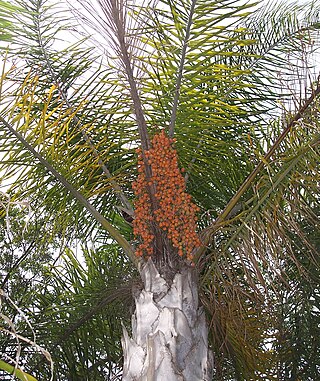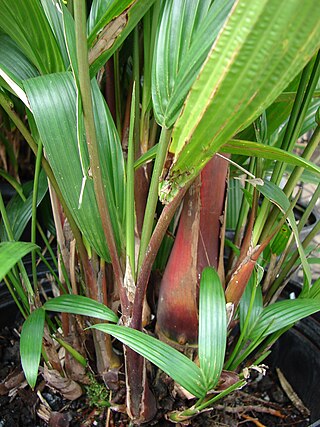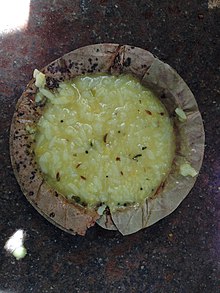
The areca nut is the fruit of the areca palm, which grows in much of the tropical Pacific, South Asia, Southeast Asia, and parts of east Africa. It is commonly referred to as betel nut, not to be confused with betel leaves that are often used to wrap it.

The betel, Piper betle, is a species of flowering plant in the pepper family Piperaceae, native to Southeast Asia. It is an evergreen, dioecious vine, with glossy heart-shaped leaves and white catkins. Betel plants are cultivated for their leaves which are most commonly used as flavoring in chewing areca nut.

In Taiwan, a betel nut beauty or binlang girl is a young woman selling betel nuts and cigarettes from a brightly lit glass enclosure while wearing revealing clothing. The term in Chinese comes from Xi Shi, the legendary beauty of imperial China's Spring and Autumn period. Though betel nuts are chewed in many regions in Southeast Asia, the betel nut beauty phenomenon is distinctly Taiwanese.

Betel nut chewing, also called betel quid chewing or areca nut chewing, is a practice in which areca nuts are chewed together with slaked lime and betel leaves for their stimulant and narcotic effects. The practice is widespread in Southeast Asia, Micronesia, Island Melanesia, and South Asia. It is also found among both Han Chinese immigrants and indigenous peoples of Taiwan, Madagascar, and parts of southern China. It was introduced to the Caribbean in colonial times.

Salacca is a genus of about 20 species of palms native to Southeast Asia and the eastern Himalayas. They are dioecious and pollinated by Curculionidae beetles.

Calamus is a genus of flowering plants in the palm family Arecaceae that is one of several genera known as rattan palms. There are an estimated 400 species in this genus, all native to tropical and subtropical Asia, Africa, and Australia.

Areca catechu is a species of palm which grows in much of the tropical Pacific, Asia, and parts of east Africa. The palm is native to the Philippines, but is widespread in cultivation and is considered naturalized in Malaysia, Indonesia, New Guinea, Taiwan, Madagascar, Cambodia, Laos, Myanmar, Thailand, Vietnam, southern China, India, Nepal, Bangladesh, the Maldives, Sri Lanka, parts of the Pacific Islands, and also in the West Indies.

Syagrus is a genus of Arecaceae (palms), native to South America, with one species endemic to the Lesser Antilles. The genus is closely related to the Cocos, or coconut genus, and many Syagrus species produce edible seeds similar to the coconut.

Daemonorops was a genus of rattan palms in the family Arecaceae. Its species are now included within the genus Calamus.

Licuala is a genus of palms, in the tribe Trachycarpeae, commonly found in tropical forests of southern China, Southeast Asia, the Himalayas, New Guinea and the western Pacific Ocean islands.

Senegalia catechu is a deciduous, thorny tree which grows up to 15 m (50 ft) in height. The plant is called khair in Hindi, and kachu in Malay, hence the name was Latinized to "catechu" in Linnaean taxonomy, as the type-species from which the extracts cutch and catechu are derived. Common names for it include kher, catechu, cachou, cutchtree, black cutch, and black catechu.

Cyrtostachys is a genus of flowering plant in the family Arecaceae. Its species are found in southeast Asia, New Guinea, and in some of the South-Central and Southwest Pacific island habitats of the Oceanian realm.

Pinanga is a genus of flowering plant of the palm family in the subtribe Arecinae. It is native to eastern and southern Asia across to New Guinea.

Heterospathe is a monoecious genus of flowering plant in the palm family found in Oceania, where it is called sagisi palm. With 39 species, Heterospathe is named from a Greek combination of "various" and "spathe", which describes the two distinct bract types.

Hydriastele is a diverse and widespread genus of flowering plant in the palm family found throughout northern Australia, Melanesia, Polynesia, and Southeast Asia. It consisted of just nine species until 2004, when molecular research, supported by morphologic similarities, led taxonomists to include the members of the Gulubia, Gronophyllum, and Siphokentia genera. About 40 species are now recognized.

Arecatannins are a class of condensed tannins in the sub-class procyanidins contained in the seeds of Areca catechu also called betel nut. The arecatannin-type natural products from Ceylonese cassia bark and Areca seed are examples of polyphenols by both current definitions, and fit the distinct definition of a polymeric phenol as well.

Areca nut production in India is dominant in the coastal region within 400 kilometres (250 mi) from the coast line, and also in some other non-coastal states of India. Areca nut, a tropical crop, is popularly known as betel nut, as its common usage in the country is for mastication with betel leaves. It is a palm tree species under the family of Arecaceae. It has commercial and economic importance not only in India but also in China and Southeast Asia.

Betel quid chewing has always been an important part of Thai culture and tradition. In the past, betel chewing was a popular daily activity among Thais all over the country. Betel comes from the plant known as Areca catechu, which grows wild all over Thailand and is known as หมาก (maak).

Areca alkaloids are a group of piperidine alkaloids found in the areca nut, the seeds of the areca palm.






















